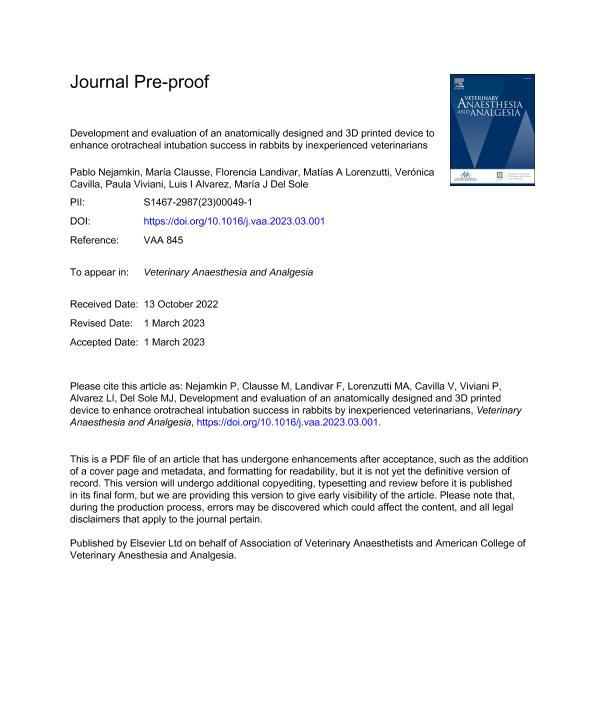Artículo
Development and evaluation of an anatomically designed and 3D printed device to enhance orotracheal intubation success in rabbits by inexperienced veterinarians
Nejamkin, Pablo ; Clausse, María
; Clausse, María ; Landivar, María Florencia; Lorenzutti, Augusto Matías
; Landivar, María Florencia; Lorenzutti, Augusto Matías ; Cavilla, María Verónica
; Cavilla, María Verónica ; Viviani, Paula
; Viviani, Paula ; Alvarez, Luis Ignacio
; Alvarez, Luis Ignacio ; del Sole, Maria Jose
; del Sole, Maria Jose
 ; Clausse, María
; Clausse, María ; Landivar, María Florencia; Lorenzutti, Augusto Matías
; Landivar, María Florencia; Lorenzutti, Augusto Matías ; Cavilla, María Verónica
; Cavilla, María Verónica ; Viviani, Paula
; Viviani, Paula ; Alvarez, Luis Ignacio
; Alvarez, Luis Ignacio ; del Sole, Maria Jose
; del Sole, Maria Jose
Fecha de publicación:
03/2023
Editorial:
Wiley Blackwell Publishing, Inc
Revista:
Veterinary Anaesthesia And Analgesia
ISSN:
1467-2987
Idioma:
Inglés
Tipo de recurso:
Artículo publicado
Clasificación temática:
Resumen
Objective: To assess whether the use of a three-dimensional (3D) printed device enhances the success rate of orotracheal intubation in rabbits. Study design: Prospective, crossover randomized controlled trial. Animals: A total of six mixed-breed rabbits. Methods: A device to guide the endotracheal tube was designed based on computed tomography images and then manufactured using 3D printing. Rabbits were randomly assigned for intubation by two inexperienced veterinarians using the blind (BLI), borescope- (BOR) or device- (DEV) guided techniques. Success rate, number of attempts, time to success, injury scores and propofol dose were recorded and compared. Significance was considered when p < 0.05. Results: Success rate was higher in DEV (58.3%) than in BLI (8.3%) (p < 0.023), but not different from that in BOR (41.6%). Total time until successful intubation was lower in DEV (45 ± 23 seconds) and BOR (85 ± 62 seconds) than in BLI (290 seconds; p < 0.006). Time for the successful attempt was lower for DEV (35 ± 10 seconds) and BOR (74 ± 43 seconds) than in BLI (290 seconds; p < 0.0001). The propofol dose required was lower for DEV (2.3 ± 1.2 mg kg–1) than for BLI (3.4 ± 1.6 mg kg–1) (p < 0.031), but not different from BOR (2.4 ± 0.9 mg kg–1). Number of attempts and oxygen desaturation events were not different among techniques (p < 0.051 and p < 0.326, respectively). Injury scores [median (range)] before and after attempts were different in BLI [0 versus 1 (0–3), p < 0.005] and BOR [0 (0–1) versus 1 (0–3), p < 0.002] but not in DEV [0 (0–2) versus 0 (0–3), p < 0.109]. Conclusions and clinical relevance: The device facilitated orotracheal intubation with a time similar to the borescope-guided technique but faster than the traditional blind technique.
Palabras clave:
AIRWAY
,
ANESTHESIA
,
EXOTIC
,
LAGOMORPHS
,
MORTALITY
,
VENTILATION
Archivos asociados
Licencia
Identificadores
Colecciones
Articulos(CCT - TANDIL)
Articulos de CTRO CIENTIFICO TECNOLOGICO CONICET - TANDIL
Articulos de CTRO CIENTIFICO TECNOLOGICO CONICET - TANDIL
Articulos(CIVETAN)
Articulos de CENTRO DE INVESTIGACION VETERINARIA DE TANDIL
Articulos de CENTRO DE INVESTIGACION VETERINARIA DE TANDIL
Articulos(IRNASUS)
Articulos de INSTITUTO DE INVESTIGACIONES EN RECURSOS NATURALES Y SUSTENTABILIDAD JOSE SANCHEZ LABRADOR S.J.
Articulos de INSTITUTO DE INVESTIGACIONES EN RECURSOS NATURALES Y SUSTENTABILIDAD JOSE SANCHEZ LABRADOR S.J.
Citación
Nejamkin, Pablo; Clausse, María; Landivar, María Florencia; Lorenzutti, Augusto Matías; Cavilla, María Verónica; et al.; Development and evaluation of an anatomically designed and 3D printed device to enhance orotracheal intubation success in rabbits by inexperienced veterinarians; Wiley Blackwell Publishing, Inc; Veterinary Anaesthesia And Analgesia; 50; 3; 3-2023; 273-279
Compartir
Altmétricas



